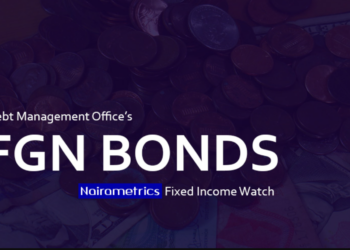The Debt Management Office (DMO) has listed its first Eurobonds on the FMDQ Securities Exchange and the Nigerian Stock Exchange (NSE).
On behalf of the Federal Government, the DMO listed the Eurobonds in a dual-tranche of $2.50 billion and a triple-tranche of $2.86 billion Eurobonds.
While commenting on the Eurobonds listing, the Managing Director of FMDQ, Bola Onadele, commended the Federal Government for the landmark achievement. According to her;
“This was yet another highly exemplary and indeed, positive step towards supporting the growth and development of Nigeria’s DCM.”
Note that a breakdown of the Eurobonds listing is as follows:
- The 7.143 percent, 12-year, $1.25 billion FGN Eurobond.
- The 7.696 percent, 20-year, $1.25 billion FGN Eurobond.
- The 7.625 percent, seven-year, $1.118 billion FGN Eurobond.
- The 8.747 percent, 12-year, $1 billion FGN Eurobond,
- And the 9.248 percent, 30-year, $0.75 billion FGN Eurobond.
Purpose of the Eurobonds: Speaking during the listing on the FMDQ in Lagos, the Director-General of the Debt Management Office, Mrs Patience Oniha, said that the bonds were raised for the refinancing of the country’s domestic debt.
According to her, the $2.50 billion Eurobonds issued in February 2018 was meant for the refinancing of domestic debt, while $2.86 billion dollars Eurobonds floated in November 2018 was purposely for the financing of the capital project of the budget.
The Eurobonds proceeds would be used to fund the fiscal deficit of the country, as well as other financing needs.
The efficiency of the Eurobonds: The Eurobond issuances are expected to spur private sector participation in the Nigerian capital markets as domestic investors stood to gain increased access to instruments in the secondary markets and a widened opportunity for portfolio diversification.
“The listing of the Eurobonds will also facilitate the inflow of foreign investment from international fund managers seeking to diversify their portfolios from both asset class and geographical perspectives, augment the domestic savings base and is ultimately expected to lead to more sustainable growth and development of the economy.”






















